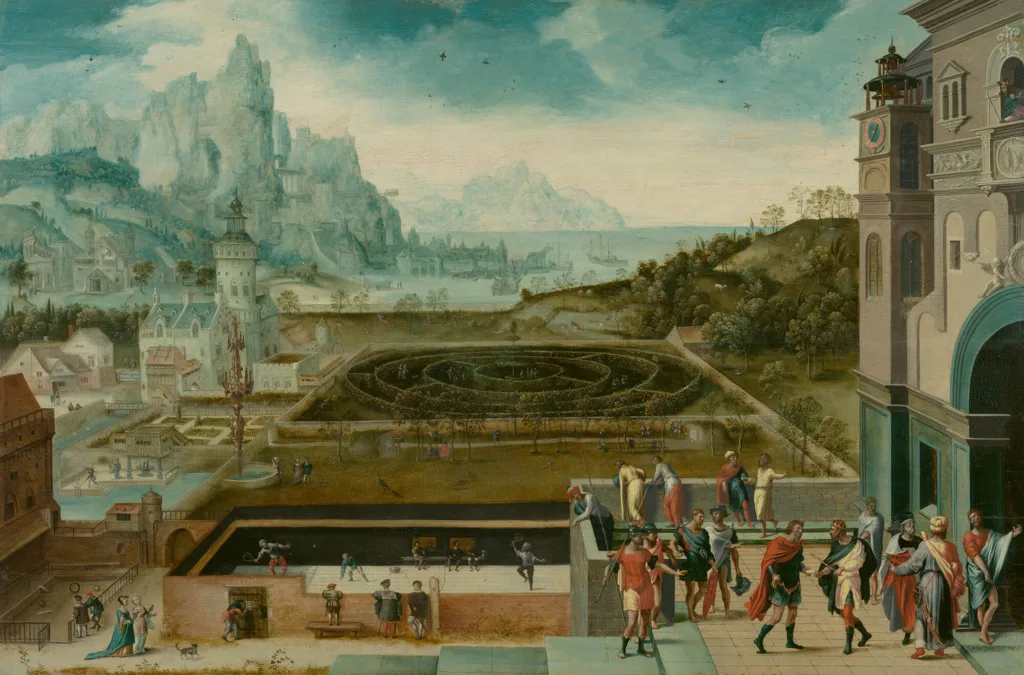The Story of David and Bathsheba at the Isabella Stewart Gardner Museum in Boston 1535-1540. 0.462 x 0.692. Herri Met de Bles. Oil on panel.
 Walking into the Veronese Room at the Isabella Stewart Gardner Museum in Boston is an experience. I noticed this painting tucked on the right side of the fireplace in a beautiful frame. I was drawn initially to the competition of foreground and background which gives this so much depth to this work. Having the background cold, blue, and blurry and the foreground bright, clear, and colorful makes you feel as if you are actually gazing out at this scene. There is a thrilling amount of detail that Herri met de Bles provides that gives you so much to look at. It was clearly set in Venice, featuring many sports and activities all over the place. The work is full of 16th century recreation and leisure that I kept finding as I moved through the scene: tennis, jestering, falconry, swimming, a ball game, archery, a maze, stag hunting, and ships in the dock. At first glance my brother and I knew something important was happening with the king which seemed to be the central scene in the painting. However, we misplaced who it was and misread the fact that it is actually a biblical scene. There are three scenes from the Second Book of Samuel Chapter 11:2-27 which portray the tragic story of the sins of King David. I wonder if there is a hidden message here that these activities lead to what David did which was to commit adultery and send a death sentence to her husband Uriah. You can barely make out Bathsheba in the public bath. A messenger appears to be giving a letter to her as she looks towards David in the castle. The paper is a billet doux or “love letter” and the paper to Uriah is a lettre de cachet or “letters of the sign or signet” which were letters signed by the king of France with direct orders.2 The soldiers seem to be urging Uriah not to take the letter but to go back to the battle. It could possibly have been the prophet Nathan at the entrance to the castle in disappointment.
Walking into the Veronese Room at the Isabella Stewart Gardner Museum in Boston is an experience. I noticed this painting tucked on the right side of the fireplace in a beautiful frame. I was drawn initially to the competition of foreground and background which gives this so much depth to this work. Having the background cold, blue, and blurry and the foreground bright, clear, and colorful makes you feel as if you are actually gazing out at this scene. There is a thrilling amount of detail that Herri met de Bles provides that gives you so much to look at. It was clearly set in Venice, featuring many sports and activities all over the place. The work is full of 16th century recreation and leisure that I kept finding as I moved through the scene: tennis, jestering, falconry, swimming, a ball game, archery, a maze, stag hunting, and ships in the dock. At first glance my brother and I knew something important was happening with the king which seemed to be the central scene in the painting. However, we misplaced who it was and misread the fact that it is actually a biblical scene. There are three scenes from the Second Book of Samuel Chapter 11:2-27 which portray the tragic story of the sins of King David. I wonder if there is a hidden message here that these activities lead to what David did which was to commit adultery and send a death sentence to her husband Uriah. You can barely make out Bathsheba in the public bath. A messenger appears to be giving a letter to her as she looks towards David in the castle. The paper is a billet doux or “love letter” and the paper to Uriah is a lettre de cachet or “letters of the sign or signet” which were letters signed by the king of France with direct orders.2 The soldiers seem to be urging Uriah not to take the letter but to go back to the battle. It could possibly have been the prophet Nathan at the entrance to the castle in disappointment.
It was helpful to discover more about this painting such as the fact that “the very complexity of this courtly landscape compels attention…our eyes wander through the scene, searching out curious and delightful incidents…the minuteness of the details challenges us to identify the biblical narrative…rather than overwhelming the story of David and Bathsheba, the landscape setting reinforces its significance.”1 This also confirms what I had seen at the gallery. I found that the artist known as “Henry with the White Lock” was of the Guild of St. Luke in 1535 and was also known as Herri de Patinir. He was known for his owls (civetta in Italian) in his paintings. Isabella Stewart Gardner bought the work in Rome in 1895.
1https://gardnermuseum.org/experience/collection/10940
2Hendy, Philip. “Herri Met de Bles.” European and American Paintings in the Isabella Stewart Gardner Museum, ISG Museum, 1974, pp. 118–120.



